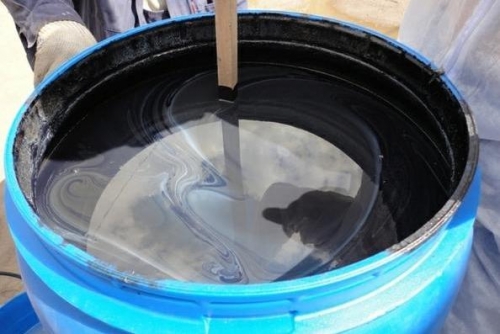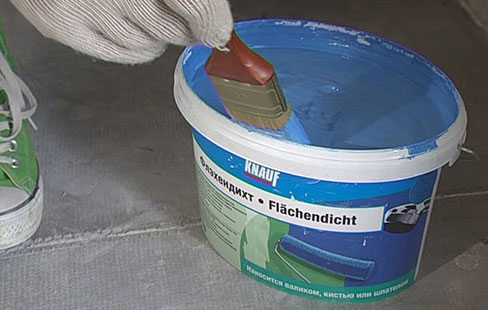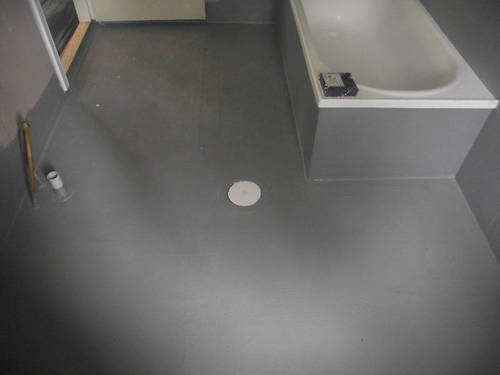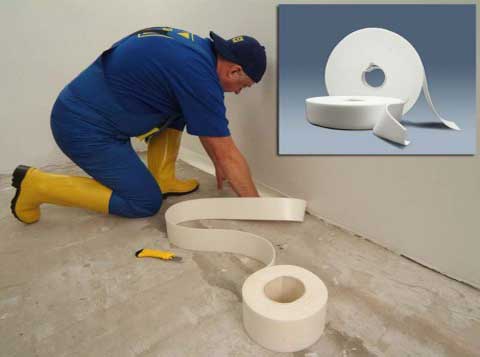Building any building involves laying the waterproofing layer. Protective moisture-repellent layer prevents the penetration of dampness inward roofing. With independent design of such a layer, the correct installation of the material plays an important role, because the term and quality of operation directly depends on this. A modern range of construction fittings offers many variations of solving problems with the choice of material, among which no recently occupies a coating waterproofing, the price of which is acceptable for both professional and private construction.
Content
- What is a coating waterproofing?
- Criteria for the classification of waterproofing materials
- Classification of coating waterproofing according to the application method
- Types of coating waterproofing material on component composition
- Advantages and disadvantages
- Where can I use coating waterproofing?
- Rules for the choice of waterproofing solution
- Consumption of coating waterproofing
- Caution waterproofing foundation
- Caution waterproofing floor
- Conclusion
What is a coating waterproofing?
The coating waterproofing is a protective coating applied to one or more layers, the thickness of which varies from 2 mm to several centimeters. To create such a coating apply special plastic materials. They are applied to the surface exposed to isolate, using coloring. 
Criteria for the classification of waterproofing materials
All waterproofing coating materials have a specific classification, in which the criteria of differences are:
- method of application;
- component composition.
Important! When choosing, also consider the type of design treated, the project volumes, the temperature regime at which work will be carried out.

Classification of coating waterproofing according to the application method
To choose a coating waterproofing, the characteristics of which will fully comply with the specified requirements and the level of your professional skills, first of all, decide on the type of solution depending on the intended principle of use. The choice is to be made of the following options:
Coolest use
The main component is water or solvents. The percentage of bitumen particles in such a mixture reaches 70%. The main advantages of such material are:
- fire safety;
- the ability to apply in residential premises;
- does not require additionally preparation.
Important! Take into account the fact that some types of solvent-based mixtures after solidification give shrinkage.

Higher coating
Such solutions require preliminary preparations before use. When heated, the coating mass acquires a plastic structure, which significantly improves the process of application. The advantages of such a material are as follows:
- relatively low cost;
- when frozen, the mass is not compressed;
- after installing there are no seams;
- quickly grabbing and hardened.

Important! Prior to use, carefully read the instructions, which contain the necessary temperature heating mode. Otherwise, the quality of the finished Obmazochnaya waterproofing layer would not meet the standards.

Types of coating waterproofing material on the component composition
To a solution of the selected finishing ideally combined with building materials with which it is in contact, check its composition. 
Depending on the constituent components of the mixture are:
- Acrylic. It is considered the most environmentally friendly material.
- Water-emulsion. It has a high degree of strength and plasticity, does not exude a sharp smell.
Important! Both first options are available in several shades, which greatly simplifies the process of selecting the material to finish the premises inside the building.

- Rubber. In addition to the main component, the crumb of rubber and dispersed emulsion has been added to the solution. This solution is most popular among such waterproofing mastics.
Important! Rubber mastics often require preheating before applying.

- Polymer coating waterproofing. Established in demand, both among professionals and among the home masters. The strength and plasticity of the coating is achieved due to the complex component composition, which includes: polystyrene, mineral crumb, rubber crumb, polyurethane.
Important! One of the main advantages of polymer compositions is the color variability, which allows you to choose not rich black material, and more acceptable under the conditions of application. This dignity is very significant when finishing inner rooms, which provide for the use of thin decorative coatings - color or performed in light colors.

- Mineral. Each manufacturer as a filler adds various natural components - ash, chalk, dolomite, cement, asbestos.
- Fooling cement waterproofing. At the heart of such a solution, there are particles of cement and polymer plasticizers, due to which the desired effect is achieved.
Important! This type of composition is one of the most cheapest and more convenient for use in any conditions, in particular in the form of a coating waterproofing of walls indoors and flooding floors.

- Emulsion. This composition is often carried out by treating the surface before applying the main layer of waterproofing, that is, as a primer. The composition contains only fine-flow bitumen dust and water.
- Rubber. Distinctive features of this coating waterproofing material are highlighted by a high heat resistance and elasticity. Therefore, the rubber solution is used in places where high demands on heat and moisture resistance are present.
- Caution waterproofing bituminous or simply construction bitumen. The application of such a mastic is quite difficult, since the mixture requires preheating to 300 ° C, but it cools very quickly. The only component is bitumen without various impurities.

Important! When buying a coating waterproofing material, consider the price varies depending on the cost of raw materials, the method of application and component composition. To make sure the proposed goods and its compliance with the standards of SNIP, ask the seller to provide you with certificates for mixtures to protect yourself from fakes, and in the future and from additional costs.

Popular brands
Another nuance is the demand for the material producer. They became famous for their quality in combination with acceptable prices of building materials such trademarks:
- Ceresit. Refractory waterproofing Cerezit is a German quality proven over the years. The range of this manufacturer is so diverse that it will make it possible to choose all consumables to perform the full volume of intended work. With respect to the distinctive technical characteristics of the water-repellent materials, it is worth noting that the recommended thickness of the coating waterproofing Ceresit is from 1.5 mm.

- Ivsil vodostop. The cooler waterproofing IVSIL Vodostop of domestic production is not at all inferior in its characteristics imported analogues. The material is suitable for finishing the solid bases of a homogeneous structure, for example, concrete, brick walls and overlaps.
- Knauf is another example of excellent German quality. In popularity, the products of this brand are not at all inferior to such a famous cerezite. The price category is also the same. Foolish waterproofing of KNAUF with wide use capabilities, a varied assortment of compositions of all species and the most subtle recommended application layer.

Advantages and disadvantages
The device of coating waterproofing is characterized by a number of characteristics, of which are somewhat very significant advantages:
- acceptable cost;
- reliable protection against moisture;
- the coating does not have seams;
- high level of elasticity prevents the formation of mechanical damages;
- a good indicator of adhesion to the surface to be treated independently from the base structure;
- resistance to aggressive chemical substances;
- durability during operation;
- opportunity to spend obmazochnye work without attracting specialists;
- easy transportation;
- the ability to work at any time of the year.

Among the disadvantages of such solutions are the following:
- high risk when applied hot lubricative compositions;
- hot solutions require the involvement of additional equipment in the performance of work;
- obmazochnye some waterproofing formulations require time delay occurs until the polymerization process is complete.

Where you can use the surface waterproofing?
Versatility distinguishes the material from others. Latitude range of application allows for the processing of such sites:
- basement and foundation;
- flat roof;
- floors, ceilings, walls;
- roofs, which are used when placing soft or roller coating;
- rooms with high humidity: swimming pools, bathrooms, basements, terraces, tanks, balconies;
- metal slab to prevent corrosion.

Important! Type of coating solution selected based on the task.
Rules for the choice of waterproofing solution
The choice of the composition Take depending on the factors described below:
- Determine under any weather conditions and temperature coating is used. Usually the manufacturer on the package indicates the operating range, do not attach importance to that, it is not recommended.
- Rate place of application, since certain kinds of solutions are intended for internal or external use.
- Calculate the area of \u200b\u200btreated surface. On the packaging material find information on consumption per 1 m2. Comparing consumption and price, find a better alternative to other manufacturers.
Important! This technique will help to save significant financial costs.

- Decide on the degree of the future load on the surface to be treated, because not every kind of surface waterproofing can be applied as a protective layer on horizontal border "wall-foundation".
Important! With strict clarity, follow these measures so that in the process of applying the mixture there is no inconvenience and shorts.

Consumption of coating waterproofing
To determine the amount of the procured mixture to create a protective layer, first read the instructions specified by the manufacturer on the package. Typically, the flow rate is always specified. 
If this information is missing, but the preferred thickness of the layer is indicated, calculate the desired amount independently. Cold Application Consumption Standards have the following values:
- 1-2 kg / m2 when decorating the roof of a rolled material;
- 2-4 kg / m2 for finishing the foundation, walls or internal surfaces of the building;
- 3.5-6 kg / m2 when decorating the roof.
Important! Hot coating flow rate is larger, but not higher than the maximum mark of the use of a cold coating solution.

Caution waterproofing foundation
To make clarity and ideas about the volume of upcoming construction work, familiarize yourself how to make the design of the waterproofing layer of the foundation. 
All actions are performed as indicated in the instructions so that the procedure does not provide large difficulties:
- Waterproofing is starting only after a complete drying of the concrete screed.
- When the irregularities and cracks are detected, close them.
- Spend the surface stripping from pollution, garbage and dust.
- Apply a layer of primer to a clean surface, observing a layer thickness of 2 mm.
Important! In the absence of primer composition, you can make it yourself. To do this, divert 1 part of the mastic in 1 part of the water.

- Wait until the base is dry.
Important! In the case of using hot coating, it is preheated to a temperature of 170-200 ° C. But remember that this solution is cooled quite quickly, therefore it will be more rational to warm up not all the mass, but separate parts necessary for processing a small area.

- Bash with a wide spatula, brush or roller, apply a layer of coating to the surface with a thickness of 2, but not more than 4 mm.
- When installing, exclude the presence of sublishes and applying excessive amounts of solution.
- Wait for complete drying, the time of which is indicated on the packaging by the manufacturer.
Important! If this information is not specified, stick to the standard 5 hours drying.
- Apply another 1 or 2 layers, between which to withstand the same technical pause.
Important! Using waterproofing coating, it is not recommended to apply to the surface of more than 3-layers.

Video
Browse the video in which it is clearly shown to make a coating waterproofing of the foundation and some processes of production of a suitable kind of mastic.
Caution waterproofing floor
With the internal decoration of the room, most often the waterproofing of walls and floors are waterproofing. When the flooring is made, consider the joints of the wall with the floor. 
All work Perform in the next sequence of actions:
- Remove pollution and dust from the processed surface.
- Apply the primer layer based on the thickness of which is not more than 2 mm.
Important! If the screed is made of concrete or cement, first moisten the surface with water from the sprayer. This approach will prevent the premature drying of the waterproofing mass applied to the porous framework structure.

- Wait for the full drying of the primer.
- Each piece of floor that can skip moisture, proof by a special sealing ribbon.
- With a wide brush, roller or spatula, apply a layer of coating with a thickness of up to 4 mm, thoroughly obscure the joints between the wall and the floor.
Important! A solution of coating waterproofing applies to such a layer to avoid the formation of irregularities and excessive assembling of mastic on one site.

- As a supplement before laying facing, wake the silicone sealant of the tile joints with silicone sealant.
Important! To understand more precisely, as the process of designing waterproofing with coating materials, look at the proposed video below.
Conclusion
All the above information undoubtedly distinguishes loosening waterproofing among many other options. With a clear compliance with all uncomplicated rules and recommendations on the performance of work, you will create reliable protection against moisture penetration, which will serve you for a long period of time - at least 15-20 years.




















